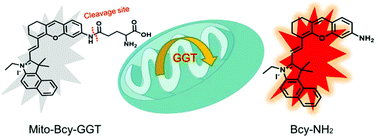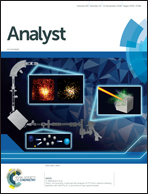A novel mitochondrial-targeting near-infrared fluorescent probe for imaging γ-glutamyl transpeptidase activity in living cells†
Abstract
γ-Glutamyl transpeptidase (GGT) plays an essential role in regulating cellular glutathione and cysteine homeostasis, and its abnormal elevation is associated with different diseases including cancers. Here a novel mitochondrial-targeting near-infrared fluorescent probe was designed for GGT by conjugating glutamate acid to a newly synthesized amine hemicyanine fluorophore. The fluorescent probe was initially non-emissive due to the formation of an amide bond which destroyed the electronic-donating ability of the amine moiety and disrupted the push–pull structure. GGT-mediated cleavage of the γ-glutamyl bond regenerated the initial fluorophore with distinct intramolecular charge transfer (ICT) and activated the fluorescence signal. The fluorescent probe displayed a linear relationship to the concentration of GGT in the range of 1.0–90 U L−1, with an estimated limit of detection (LOD) of 0.4 U L−1. Its ability to target and image mitochondrial GGT activity was demonstrated in living cells with high specificity and fast response. We believe our near-infrared fluorescent probe could have great potential in imaging mitochondrial GGT activity and elucidating GGT-associated pathological consequences in living cells and even small animal models.



 Please wait while we load your content...
Please wait while we load your content...